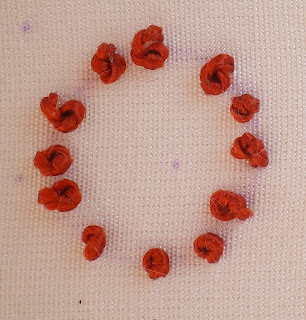When members of the Embroiderers' Guild forum started planning a Christmas card and ornament swap back in July, I thought that was a time frame that even I could handle. Of course, because I had plenty of time, I didn't get started straight away except to mentally plan what I wanted to do. In fact I only began to stitch in October after I purchases the bright Christmassy red silk that I wanted to use at the Alli Palli Stitching and Knitting Show.
I've been dieing to show and tell this little project but part of the fun of a swap is that the recipient does not get to see the item until they actually receive it.
Well, the swap date has arrived (in Australia, at least) and I know for certain that Elizabeth has received her ornament, I can finally blog it.
The swap called for a Christmas card and an ornament. I cheated, or was creative depending on how you view it, and made a card/ornament.

I wanted the ornament to look like a Christmas bauble. On the top half, I embroidered a design that I had learnt while stitching Suehiro. The design, called Flax leaf, is stitched over a weft foundation. On the bottom half, I attempted a design that I have not stitched before, 3-d effect. The design is stitched in 3 or more shades of the same colour. Around the centre of the bauble, I stitched a gold ribbon.

On the reverse of the bauble, I stitched the date.
When I had finished stitching the design I was feeling pleased that I had finished in good time ... until I remembered that I had to 'finish' the ornament.
I cut four circles of card - two from mount board and two from a cereal box - and two more from wadding. I laced the front and back onto the mount board using the wadding to give some padding. I covered the cereal box circles in plain fabric using PVA to secure the seam allowance to the wrong side. I then joined the front to a plain circle using ladder stitch and repeated the process for the back. This was when I realised that using PVA to secure the fabric was a bad idea. The PVA dries very hard and is extremely difficult to stitch through. I had a very sore finger to prove the point for several days!
I secured each end of a single ribbon between each pair of circles to create a hanger and stitched lengths of the same gold ribbon around the sides of the front and back to hide the join. From the remaining silk, I made a small tassel to hand on the bottom of the ornament.
Finally, I made an insert from silk paper onto which I wrote my greeting to Elizabeth.

Did you notice that when I made up the ornament, I turned the front up-side-down so that the solid red Flax design was on the bottom. When it came to it, the ornament told me that it wanted to hang this way up!
Despite the long time frame, I did not meet the dead line for posting my ornament. Fortunately, the postal service was kind to me and safely delivered it to Australia in only five days instead of the 10-12 I had expected.
I hope Elizabeth likes her ornament. I certainly enjoyed stitching it for her.
Happy Stitching

















